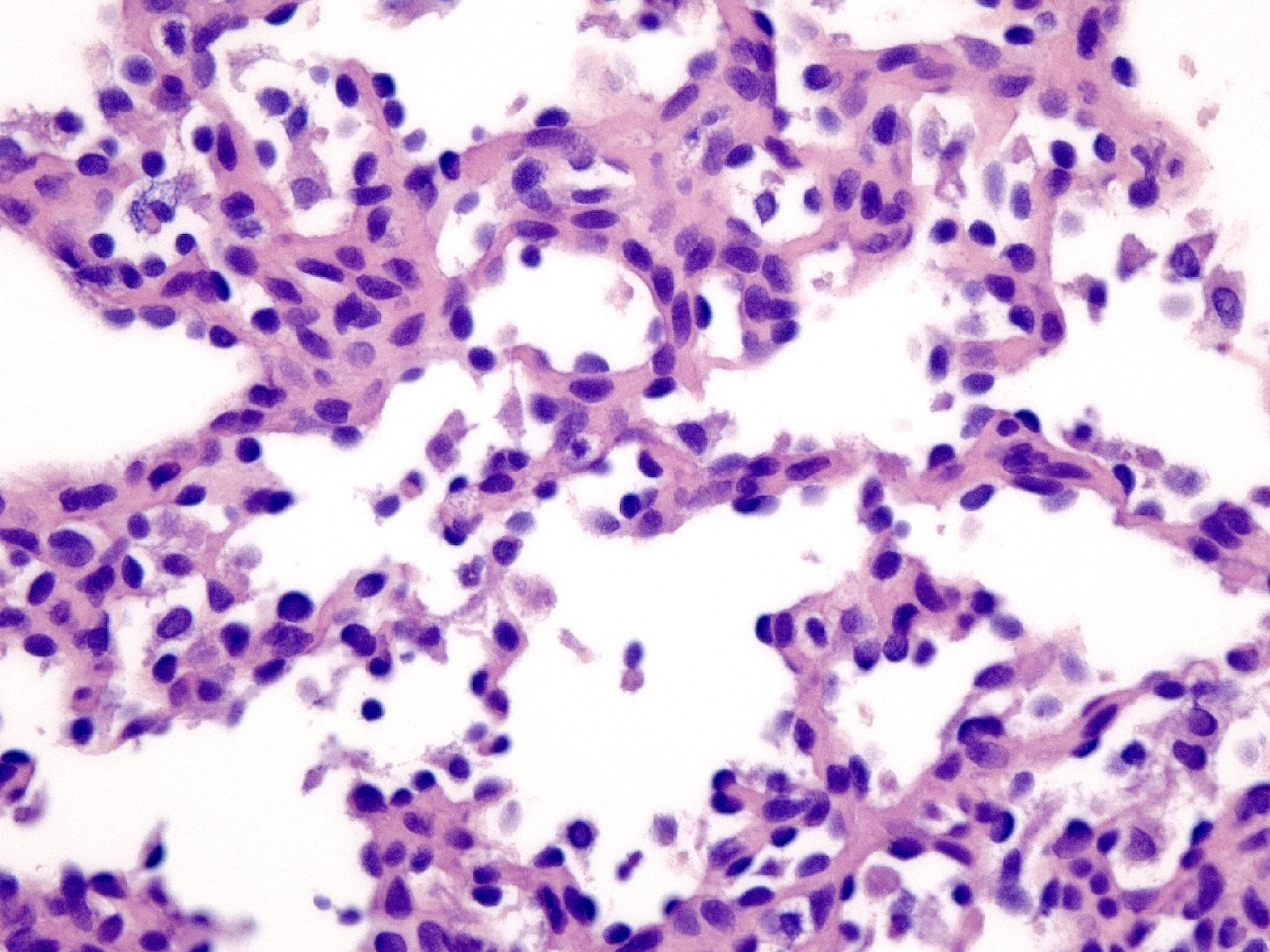Table of Contents
Definition / general | Essential features | ICD coding | Epidemiology | Sites | Pathophysiology | Etiology | Clinical features | Diagnosis | Laboratory | Radiology description | Radiology images | Prognostic factors | Case reports | Treatment | Gross description | Gross images | Frozen section description | Frozen section images | Microscopic (histologic) description | Microscopic (histologic) images | Positive stains | Negative stains | Electron microscopy description | Electron microscopy images | Molecular / cytogenetics description | Videos | Sample pathology report | Differential diagnosis | Additional references | Board review style question #1 | Board review style answer #1 | Board review style question #2 | Board review style answer #2Cite this page: Samiei A, Dehner C. Anastomosing hemangioma. PathologyOutlines.com website. https://www.pathologyoutlines.com/topic/softtissueanastomosinghemangioma.html. Accessed April 1st, 2025.
Definition / general
- Rare, benign vascular neoplasm of viscera, retroperitoneal and paravertebral soft tissue
- Tightly packed, anastomosing, capillary sized blood vessels with frequent hobnail endothelial cells; must be differentiated from well differentiated angiosarcoma
Essential features
- Deep soft tissue or viscerally located benign vascular neoplasm, often discovered incidentally
- Circumscribed, small to medium sized anastomosing vascular channels with scattered hobnail endothelial cells, fibrin thrombi, intracytoplasmic eosinophilic hyaline globules and intravascular hematopoiesis
- Mimics well differentiated angiosarcoma radiologically and histologically
- Predilection for genitourinary tract and paravertebral soft tissues
- Harbors recurrent mutations in GNA genes (GNAQ, GNA14 and GNA11)
ICD coding
Epidemiology
- Wide age range (2 - 85 years), predominantly fifth to seventh decade (Am J Surg Pathol 2016;40:1084, Diagn Pathol 2017;12:14)
- M > F (M:F = 1.3 - 2.3:1 for renal anastomosing hemangioma) (Diagn Pathol 2017;12:14, Cureus 2024;16:e55351)
Sites
- Most commonly found in paravertebral soft tissue, kidney (especially renal hilum or medulla), ovary and testis (Am J Surg Pathol 2016;40:1084, Am J Surg Pathol 2009;33:1364, Int J Gynecol Pathol 2023;42:167, Pathol Oncol Res 2017;23:717, Am J Surg Pathol 2013;37:860)
- Less common sites include adrenal glands, gastrointestinal tract and liver, spermatic cord, bladder (one case reported), larynx (one case reported) and breast (Histopathology 2023;83:791, Am J Surg Pathol 2013;37:1761, Front Surg 2022;9:930160, Mol Clin Oncol 2016;4:310, Ann Otol Rhinol Laryngol 2021;130:298, J Breast Cancer 2020;23:326)
Pathophysiology
- Unclear but appears to develop in the context of chronic kidney disease and renal cell carcinoma in renal anastomosing hemangioma
- Most of the reported cases have been found to have mutations in GNA genes (GNAQ, GNA14 and GNA11)
Etiology
- Unknown
Clinical features
- Frequently, incidental finding and asymptomatic
- May present with mass effect, hematuria, pain, pleural effusion and anemia
- Occasionally multifocal (J Endourol Case Rep 2017;3:176)
- Tendency to occur in the context of end stage renal disease (Histopathology 2014;65:309)
Diagnosis
- Diagnosis is primarily based on histological findings
- Confirmation can be achieved through molecular testing for GNAQ, GNA14 or GNA11 mutations
Laboratory
- Anemia may be present secondary to hematuria in some cases
- Elevated CA-125 in some cases with intraovarian lesions (Int J Gynecol Pathol 2023;42:167)
Radiology description
- General appearance: radiologic findings are nonspecific, typically showing a circumscribed mass that often appears solid
- Computed tomography (CT) scan: avidly enhancing lesion on contrast enhanced CT and heterogeneous attenuation due to the presence of fat or nonenhancing components (Abdom Radiol (NY) 2016;41:1325)
- Ultrasound: hypoechoic mass with minimal blood flow signals, which demonstrates a homogeneous enhancement with slow in and slow out pattern (Front Oncol 2023;13:1269631)
- MRI: high signal intensity on T2 weighted imaging and contrast enhancement in arterial phase (Curr Oncol 2018;25:e220)
- Lesions involving the liver may appear more infiltrative and grow very large (Hum Pathol 2016;54:143, Hum Pathol 2018;78:159)
Radiology images
Prognostic factors
- Overall prognosis is excellent, regardless of multifocality or infiltrative features
Case reports
- 52 year old woman with a 0.8 cm liver mass (Radiol Case Rep 2022;17:4889)
- 57 year old woman with a 4.1 cm retroperitoneal mass (Front Oncol 2023;13:1269631)
- 62 year old woman with an 11.2 cm right ovarian cystic mass (Int J Surg Pathol 2019;27:437)
- Woman in her 70s with a 4 cm mass of adrenal gland (Mayo Clin Proc 2024;99:1192)
- 84 year old man with a 2.3 cm painful right scrotal mass (Front Surg 2022;9:930160)
Treatment
- Simple surgical excision is curative
Gross description
- Well circumscribed vascular lesion
- Hemorrhagic, spongy, mahogany-brown cut surface
- Ranges between 1 mm and 8 cm (average: 2.2 cm)
- Reference: Am J Surg Pathol 2016;40:1084
Gross images
Frozen section description
- Well circumscribed vascular proliferation with bland to hobnail endothelial lining
- Hemorrhage, edema or degenerative changes may be seen
- Absence of mitosis, necrosis or atypia
- Reference: J Microsc Ultrastruct 2022;10:208
Frozen section images
Microscopic (histologic) description
- Well circumscribed vascular proliferation, with occasional focal infiltration into peripheral adipose tissue
- Thin walled, anastomosing, capillary sized blood vessels
- Adjacent medium to large caliber vessels commonly found
- Single layer of bland to hobnail endothelial cells
- Mitotic figures are absent or rare
- No necrosis
- No nuclear pleomorphism or atypia
- Intravascular fibrin thrombi commonly seen
- Occasional areas of congestion, hemorrhage, edema, sclerosis or myxoid degeneration
- Intracytoplasmic eosinophilic hyaline granules commonly found
- Intravascular hematopoiesis (may be composed of premature erythroid, myeloid or megakaryocytes)
- Solid growth pattern may be seen
- Background loose stroma with stromal spindle cells
- Less common findings
- Intralesional fatty change or foamy macrophages
- Intravascular growth pattern
- Stromal luteinization in most cases of anastomosing hemangiomas of the ovary (Gynecol Oncol Rep 2020;34:100647)
Microscopic (histologic) images
Contributed by Azadeh Samiei, M.D., Carina Dehner, M.D., Ph.D. and Jessica L. Davis, M.D.
Positive stains
- Endothelial markers, including CD31, CD34, ERG, FLI1 and factor VIII (Am J Surg Pathol 2009;33:1364, Am J Surg Pathol 2016;40:1084)
- Ki67 / MIB1 shows a low proliferation index (Diagn Pathol 2014;9:159)
Negative stains
Electron microscopy description
- Homogeneous electron dense globules of varying sizes (170 - 450 nm) within the endothelial cytoplasm, some demonstrating coarse granular structures
- Increased number of primary lysosomes admixed with larger heterogeneous granules (uranyl acetate and lead citrate)
- Negative for Reinke crystals in anastomosing hemangioma of the ovary (Int J Surg Pathol 2019;27:437, Am J Clin Pathol 2011;136:450)
Molecular / cytogenetics description
- Recurrent mutations in GNAQ (Q209), GNA14 (Q205) and GNA11 (Q209) in 70 - 91% of cases (Mod Pathol 2017;30:722, Histopathology 2018;73:354, Virchows Arch 2020;476:475)
Videos
Anastomosing hemangioma
Sample pathology report
- Soft tissue, paravertebral, excision:
- Anastomosing hemangioma (see comment)
- Comment: Sections show a benign vascular neoplasm composed of thin walled, anastomosing vascular channels lined by a single layer of bland, hobnailed endothelial cells. Several fibrin thrombi are also appreciated. Immunohistochemical stains show that the endothelial cells are positive for CD31, CD34 and ERG. Smooth muscle actin highlights a normal, retained pericyte layer. The overall findings are supportive of the above diagnosis.
Differential diagnosis
- Angiosarcoma:
- Diffusely infiltrative growth pattern
- Multilayering of endothelial cells
- Increased mitosis, necrosis and nuclear atypia
- May express cytokeratin, EMA, CD30 and D2-40 (Appl Immunohistochem Mol Morphol 2014;22:358)
- Retiform hemangioendothelioma:
- Involves the subcutaneous tissue of the trunk and extremities
- Resembles normal rete testis with elongated, arborizing vascular channels and commonly, perivascular lymphocytic infiltrates
- High propensity for local recurrence
- Hobnail (targetoid hemosiderotic) hemangioma:
- Dermal based hemangioma
- Typically involving lower extremity and less commonly, upper extremity or oral cavity
- Wedge shaped vascular proliferation with dilated superficial and smaller deep dermal vessels
- Hobnail endothelial lining
- Prominent stromal hemorrhage and hemosiderin deposition
- Intravascular papillary projections may be seen
- Kaposi sarcoma:
- Mostly involves the skin
- Slit-like vascular spaces
- Infiltrative growth pattern
- Eosinophilic hyaline globules
- Plasma cells are a typical finding
- Endothelial cells are positive for both endothelial markers and lymphatic markers
- Nuclear expression of HHV8 in 100% of the cases
- Papillary intralymphatic angioendothelioma (Dabska tumor):
- Dermal based infiltrative vascular neoplasm with intravascular papillary proliferations lined by hobnail endothelial cells
- Typically occurs in children, on distal extremities
- High rate of local recurrence and rare metastasis
- Most cases coexpress endothelial markers (including CD31, CD34, factor VIII) and lymphatic markers (D2-40 and VEGFR3)
- Papillary endothelial hyperplasia (Masson tumor):
- Intravascular papillary endothelial proliferation
- Located in deep dermis or subcutaneous tissue
- Often appears on head and neck, fingers and trunk
- Often surrounded by a pseudocapsule
- Weibel-Palade bodies present on electron microscopy
- Lobular capillary hemangioma (pyogenic granuloma):
- Lobular configuration of capillary vessels
- Numerous capillary channels radiating from larger feeding vessels
- Edematous to fibromyxoid stroma
- Angiomyolipoma:
- Accessory splenic tissue or splenosis:
- Develops secondary to previous trauma or splenectomy
- Normal splenic tissue with a capsule and composed of red pulp (loose reticular network of capillaries and venous sinusoids), white pulp (periarteriolar sheaths of lymphocytes) and penciller arterioles
- Sinus endothelial cells express endothelial markers and CD8
Additional references
Board review style question #1
A 56 year old man with end stage renal disease presents with a periadrenal mass discovered incidentally on imaging. The mass is 4 cm, well circumscribed, vascular and hemorrhagic in appearance. A nephrectomy is performed. Microscopic evaluation of the lesion reveals anastomosing vascular channels lined by bland endothelial cells with minimal atypia. The vascular spaces resemble splenic sinusoids and show focal thrombosis and extramedullary hematopoiesis. There is no significant mitotic activity, no cytologic atypia or necrosis. Immunohistochemical staining is positive for CD31 and ERG and negative for AE1 / AE3. Which of the following is true about the periadrenal hemangioma shown in the above image?
- Always symptomatic
- Low proliferation index (Ki67 index)
- Positive for HHV8 immunostaining
- Prognosis is poor with high recurrence
Board review style answer #1
B. Low proliferation index (Ki67 index). The lesion shown is an anastomosing hemangioma, which is a benign tumor with low mitotic activity. Ki67 index is usually low in endothelial cells. Answer C is incorrect because anastomosing hemangioma is not related to HHV8 infection. Answer D is incorrect because the tumor has a good prognosis without recurrence. Answer A is incorrect because anastomosing hemangioma frequently presents as an incidental finding on imaging.
Comment Here
Reference: Anastomosing hemangioma
Comment Here
Reference: Anastomosing hemangioma
Board review style question #2
A 40 year old man presents with an incidental mass in the kidney. Histologically, the lesion consists of an intricate network of small, anastomosing blood vessels lined by hobnail endothelial cells, intravascular thrombosis and extravascular hematopoiesis. Immunohistochemistry shows expression of CD31, CD34 and ERG and is negative for cytokeratin and EMA. Which of the following molecular findings is most consistent with anastomosing hemangioma?
- GNAQ mutation
- KDR mutation
- TFE3 gene rearrangement
- YAP1::TFE3 fusion
Board review style answer #2
A. GNAQ mutation is seen in most anastomosing hemangiomas. Answer D is incorrect because YAP1::TFE3 fusion occurs in a subset of epithelioid hemangioendotheliomas. Answer C is incorrect because TFE3 mutations occur on microphthalmia (MiT) family translocation renal cell carcinomas, also known as Xp11 translocation renal cell carcinomas. Answer B is incorrect because KDR is a mutation seen in angiosarcomas.
Comment Here
Reference: Anastomosing hemangioma
Comment Here
Reference: Anastomosing hemangioma






































